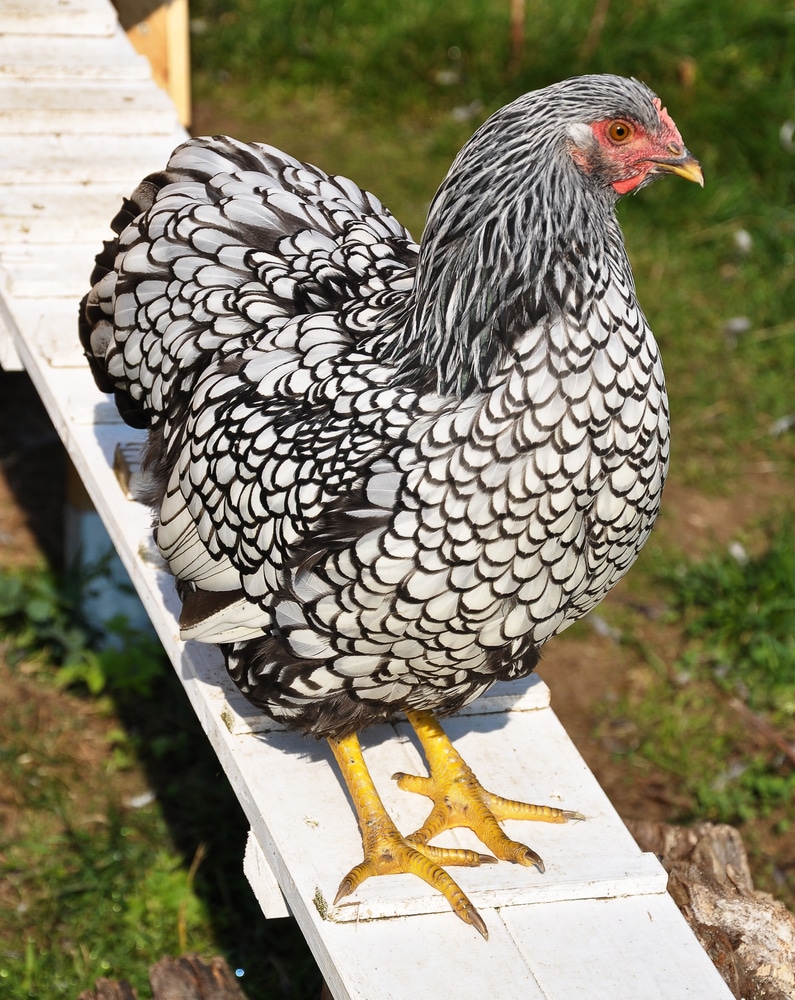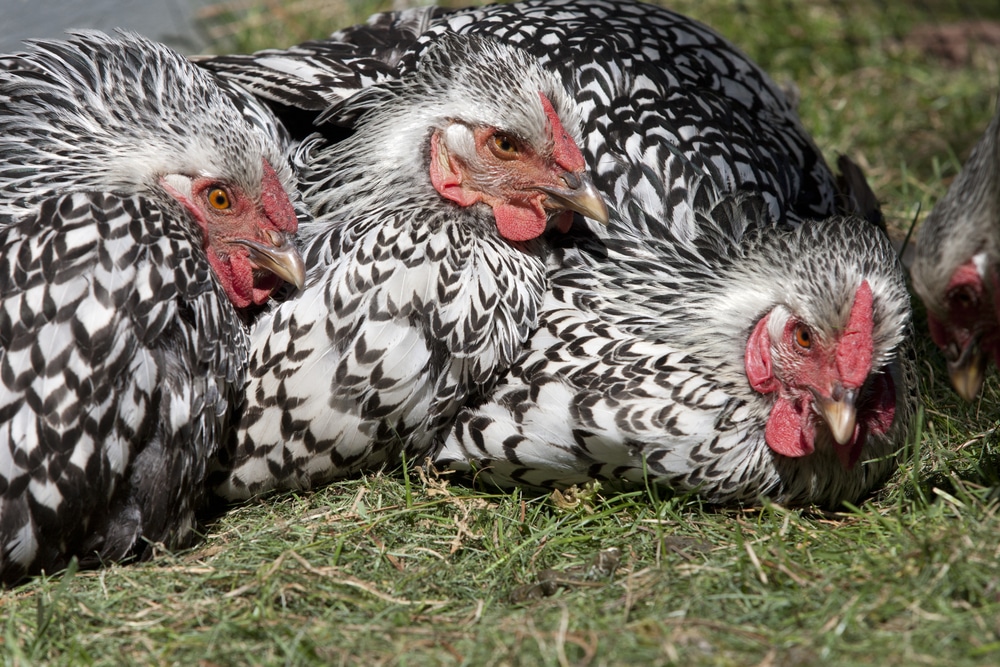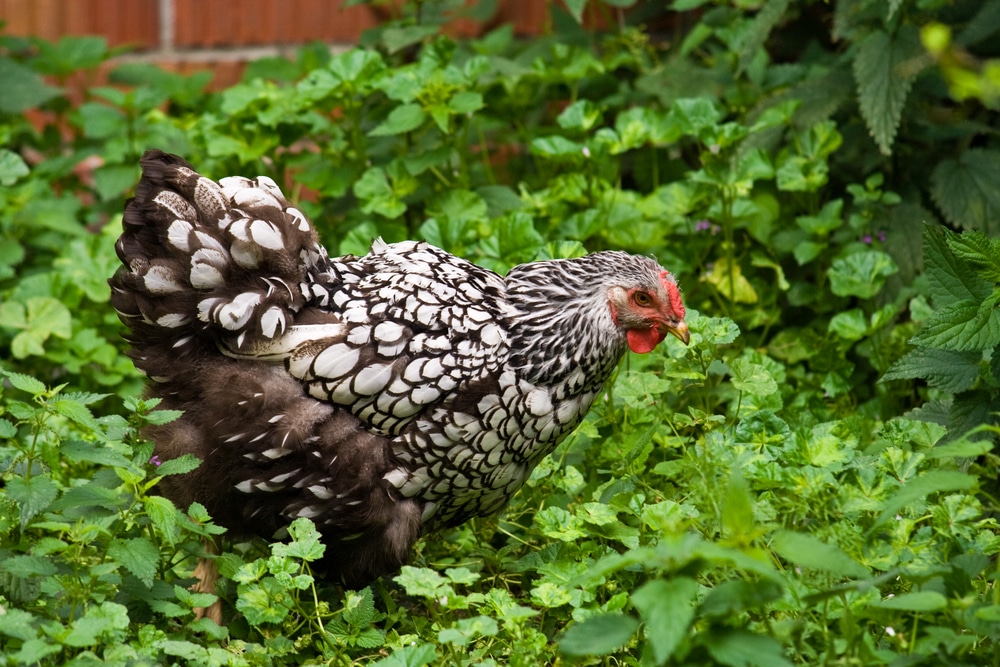They’re a little bit broody, a wee bit moody, and absolutely spectacular to look at. What’s not to love about the illustrious Wyandotte chicken?
These birds are popular all over the world, not just because they’re so gorgeous to look at, but also because they are prized for their exceptional laying and mothering abilities.
With an average lifespan of six to twelve years, these birds will quickly become members of your family.
Here’s what you need to know about this popular all-American chicken breed.
Table of Contents
Wyandotte Chicken Overview
Here are some of this breed’s notable traits to help you decide if you want to consider raising them.
| Lifespan | 6 to 12 years |
| Weight | Up to 9 pounds |
| Appearance | Large, sturdy body with many color varieties |
| Egg Color | Brown |
| Egg Production | About 200 per year |
| Good for Beginners? | Yes |
| Minimum Coop Size | 4 to 5 square feet per bird |
| Price | $2.50 to $5.00 per chick |
History of the Wyandotte Chicken
An American chicken breed, the Wyandotte is native to the state of New York. In fact, the name is actually the same as a recognized Native American tribe and language.
Although the Wyandotte people didn’t really have much to do with the chicken, the name stuck out of a dedication to the Native Americans who helped out the first white settlers in the area.
Other than that, it’s unclear why the name Wyandotte was chosen for this particular breed of chicken.
Either way, there are several varieties of Wyandotte that are formally recognized, including the Silver Laced, the Partridge, and the Buff. Silver Laced is believed to be the first type of Wyandotte chicken bred.

A popular show breed, the Wyandotte isn’t going to fade into the background anytime soon. In fact, new variations and color varieties of the breed are being developed each and every day. It even comes in a bantam size!
Creating Dual-Purpose Chickens
A dual-purpose breed, the Wyandotte has a heavy weight and can also be considered one of the most productive egg laying chicken breeds. These chickens are believed to have originated sometime in the late 1800s.
Developed by four people, John Ray, H.M. Doubleday, Fred Houdlette, and L. Whittaker, the WYandotte was one of the first dual-purpose birds.
It was originally referred to as the American Sebright chicken, but the name was changed by the American Poultry Association.
The first Wyandotte variety to appear was a Silver-Laced variety. This was developed somewhere in upstate New York in the 1860s.
A short time later, the Gold-Laced WYandotte – one of today’s most popular breeds – appeared.
The Gold-Laced Wyandotte Was created with genetics from a Silver-Laced Wyandotte hen and a gold-spangled Hamburg and Partridge Cochin cock.
This unique variety wasn’t originally called a Wyandotte at all but instead a Winnebago.
The Wyandotte made its first international voyage in the 1880s, making the trip across the Atlantic to be showcased to British poultry purveyors.
It became so popular that by 1904, the cost of buying a Wyandotte chicken was equivalent to the cost of buying a small house!
Appearance of the Wyandotte Chicken

A sturdy chicken, the Wyandotte weighs in at up to nine pounds. It can be found in a variety of colors that are recognized by the American Poultry Association, as well as other colors that have yet to be formally acknowledged. Wyandotte roosters tip the scales at up to nine pounds, while hens are slightly smaller, at six or seven.
You can also find bantam-variety Wyandotte chickens. These usually weigh between 36 and 42 ounces.
A deep, full-breasted chicken, the Wyandotte has a large frame along with a large head and a deep rose comb. A rose comb is simply one that sits closer to the head of the chicken instead of standing erect and upright, which is what you might see on other breeds of chickens. This comb is not only beautiful to look at, but helps to protect the chicken from harsh winter weather conditions like frostbite.
The Wyandotte is a well-rounded bird that makes it perfect for the dinner table.
According to the American Poultry Association standard, the Wyandotte chicken should have yellow skin and yellow legs. The legs are clean and without any feathers, possessing four toes on each foot. The legs are sturdy, able to hold the heavyweight of the chicken.
The face, earlobes, comb, and wattles of the Wyandotte chicken are all red, with a beak that is a dark golden-yellow in color. The eyes are uniquely orange.
Color Varieties
The rest of the appearance of the chicken breed will vary depending on what color variety it is. The gold-laced variety has, as you might expect, golden feathers that are laced with deep black. They also have some subtle veining.
Other variants recognized by the American Poultry Association include:
- Silver Laced: created as a cross between a silver-spangled Hamburg and a dark-colored Brahma
- Gold Laced: created in Wisconsin as the result of breeding a Partridge Cochin, Gold Spangled Hamburg, and Silver Laced Wyandotte
- Black
- Partridge: a cross between a Buff Wyandotte and a Partridge Cochin
- Buff: a cross between a Silver Laced Wyandotte and a Buff Cochin
- Silver Penciled
- Blue
- Colombian: created as a cross between a Barred Plymouth Rock and a white Wyandotte
These same variants are also recognized in Great Britain, with the addition of barred, buff laced, red, and white Wyandottes, too. Bantam Wyandottes were admitted to the standard in 1933.
Today, they are somewhat difficult to find, but can still be located in select areas.
For chicken keepers who are seeking a smaller breed of bird, the bantam variety is often the perfect fit.
Behavior of the Wyandotte Chicken
As docile, friendly birds, Wyandotte chickens are known as being some of the best backyard chickens you can raise. They enjoy being able to forage and free range but can also tolerate confinement quite while.

Combining a mixture of the two is recommended for mots backyard chicken keepers, this will allow you to provide your chickens with all the protection (and access to tasty bugs and pasture!) that they need.
Do They Get Along with Other Birds?
Calm and easy to get along with, the Wyandotte tends to get along well with most other chickens.
It can be cranky from time to time, however, and won’t do well with chickens who like to be at the top of the pecking order – the Wyandotte means business, and it’s here to stay.
This chicken has a ferocious dominant streak and won’t take kindly to being bullied.
You will likely find that your Wyandotte chickens spend much of their time alone. They are aloof and tolerate confinement well, but also enjoy free-ranging.
They will have a ball going after the seed, bugs, and other critters wandering about your lawn.
That said, these chickens aren’t prone to hurrying. They will take their time and patrol at their own pace, not too worried about what the other birds in the flock are doing.
Interactions with Humans
While Wyandottes aren’t exactly known for being lap chickens, they aren’t aggressive, either. Although being cuddled definitely won’t be their favorite pastime, you shouldn’t have to worry about these chickens going after your small children or pets.
In fact, Wyandotte chickens are popular exhibition or 4H birds, since it generally takes quite a lot to upset them.
They are known for being top award-winners in the show ring, too, both for their personable demeanors and their stunning appearances.
Wyandotte Chicken Productivity
Here is a quick run down of the type of productivity that you should expect from Wyandotte chickens:
Egg Production
Many people choose to raise the Wyandotte chicken for eggs. Not only will it lay about 200 large brown eggs each year, but it won’t stop laying during the winter months.
This is a common problem with other breeds of chickens, who tend to stop egg production altogether during the colder months of limited daylight.
Most Wyandotte chickens will lay about four medium to large eggs each week. The excellent laying abilities of the Wyandotte hen is something that is unique to this breed.
In fact, many dual-purpose chickens have notoriously poor egg production. After all, you have to make compromises somewhere!
However, this is far from the case with the Wyandotte. It will continue to produce lots of eggs all year for you, regardless of the season.
Meat Production
Wyandotte chickens are also commonly raised for meat. This old-fashioned breed is considered a heritage breed in that it takes longer to reach table weight.
However, most Wyandotte chickens will be ready for slaughter at around four months of age.
While the meat will be the most tender if you slaughter at this time, you don’t have to do it at this time.
You can wait for as long as eight months to butcher your chickens. After about eight months, the meat will start to get tough.
Wyandottes aren’t known for being overly fatty, especially when compared to other dual-purpose heritage chickens like Orpingtons.
However, the carcass is nice and full and will yield you plenty of meat, filling out well after 20-25 weeks.
When you are raising meat birds of any kind, but especially heritage chickens like Wyandottes, remember that what you feed your chickens will play a huge role in how the meat tastes.
Allowing your chickens to free-range and eat morenatural foods (instead of gorging themselves on grain) will lend to a carcass that is leaner and has a finer flavor.
Health Problems of Wyandotte Chicken
One of the many benefits of raising Wyandotte chickens is that they are mostly self-sufficient.
They are feathery and fluffy, though, so with all chickens, you will want to keep an eye out for problems like external parasites.
Lice and mites can be particular issues, so inspect them on a weekly basis to make sure everything looks to be in tip-top shape.
Providing regular access to dust bathing facilities can help your Wyandotte chickens prevent problems with parasites.
It also encourages good social behaviors, so adding even a rudimentary dust bath to your chicken run is super beneficial. Regular deworming can also help to keep these parasites at bay.
Another issue related to the thick, downy feathering of this bird has to do with its rear end.
Because it’s behind is so amply feathered, you may notice issues with droppings messing up the backside of our birds. If it becomes an issue, simply trim the features and you should be good to go.
As with all chickens, it’s important that you remember to provide adequate fresh water and plenty of nutritious feed. You will also want to supply a safe, secure chicken coop for your chickens to roost at night – and of course, to lay their eggs!
Raising Wyandotte Chicks
Wyandotte hens are known for being exceptionally broody. They are reliable sitters, often resting on fertile eggs. They go broody often and when their eggs hatch, they are fantastic mothers, ending to their baby chicks with care.
When you have Wyandotte chicks, you don’t need to do much else besides the basic level of care that you would give to chickens of any breed.
As adults, your Wyandotte chickens will need a basic laying feed. Be careful about feeding too much laying feed if you are also raising roosters in your flock – too much calcium can cause kidney and liver problems.
Keep in mind that, since Wyandottes are larger, they will need a bit more space per bird to prevent riding and fighting. While you can sometimes get by with as little as two square feet per bird in the coop with other chicken breeds, you will want to up that to a minimum of four (but ideally five) square feet per bird with your Wyandottes. Add an additional ten to twelve square feet per bird out in the run.
The more space you can give your Wyandotte chickens, the better!
Make sure the coop in which you are housing your Wyandottes is ventilated but also free of excessive drafts. This will help prevent chilling during the winter months.
Benefits of Raising Wyandotte Chicken
There are lots of benefits to raising these large, healthy birds. Here’s an overview of the pros:
- Thrive in a variety of climates
- Can handle confinement well
- Great at foraging
- Rarely targeting by airborne predators
- Great egg production
- They’ll incubate the eggs for you
- Great meat production
Adaptable to Extreme Temperatures
Wyandotte chickens are prized for their versatility in a variety of climates. Not only are they hardy in cold winter conditions due to their heavy weight and feathering, but they can also survive in warmer environments, too.
Just make sure you have a well-ventilated coop and plenty of shade for those warmer months.
In the winter, though, is where the Wyandotte chicken really showcases its strengths. This chicken is hardy and can withstand winter temperatures with ease – even temperatures well below zero.
Since the Wyandotte is large and has a rose comb (instead of a single cob), it does much better in cold temperatures. It has less flesh exposed to the cold air and a reduced risk of frostbite.
Adaptable to Different Enclosures
Wyandotte chickens are highly adaptable, tolerating confinement well. At the same time, they are also good foragers.
You won’t have to worry too much about predators while your birds are out foraging, either.
Airborne Predators Aren’t a Threat
Although Wyandottes are still chickens, and therefore prone to predation from large animals like coyotes and foxes, they are large enough where you usually won’t have to worry about your Wyandottes being sniped by hawks or other airborne predators.
Great Egg Production
Another benefit of raising Wyandotte chickens is their versatility on your homestead. Not only can this chicken produce more than 200 eggs each year, but it will also go broody.
You don’t have to rely on an incubator if you want to hatch your own eggs at home – you just need a Wyandotte hen and a rooster to fertilize the eggs.
Great Meat Production
Finally, if you plan on raising the Wyandotte for both eggs and meat, you probably already know how good this chicken is for meat production.
Even if you only want to raise your Wyandottes for eggs, there’s a benefit to be noted here.
When your Wyandotte hens stop producing (which is often long before they will die of natural causes), you can take care of your chickens by transforming them into dinner table birds.
Challenges of Raising Wyandotte Chicken
There are very few disadvantages to raising Wyandotte chickens in your backyard flock. Here’s an overview of what to expect:
- Personalities can vary
- Some can be loud
- Fights could break out
- Extra caution is needed in warm weather
Unpredictable Personalities
One of the biggest is that the personalities of your Wyandottes can be a bit much to deal with the first time you interact with them. Not all Wyandottes like being held and handled, which can be frustrating for new chicken keepers.
Noise Levels
Although most hens are known for being mostly quiet, Wyandottes are super chatty.
These hens will make noise not just when they are laying eggs, but at all times throughout the day.
Roosters, too, make pronounced crowing noises. These aren’t attributes exclusive to the Wyandotte breed – all chickens make noise, of course – bu Wyandottes are known for being a bit more vocal and boisterous.
Unexpected Fights
You will also need to pay close attention to the dynamics within your flock, especially if you are introducing your Wyandottes to an established group of chickens. Keep an eye out for any issues related to dominance, as your Wyandotte will want to be top dog and won’t take kindly to being pushed around.
Warm Weather Can Pose Risks
Finally, you will want to keep a close eye on your Wyandottes during the summer, particularly if you live in a warm environment.
While Wyandottes are exceptionally well-suited to the cold, their dense feathering makes them less-than-ideal for warmer weather. Be sure to provide plenty of shade and clean, fresh water at all times.
Frequently Asked Questions
Are you considering caring for Wyandottes? If so, the following questions might be helpful.
What is the Most Common Type of Wyandotte?
Silver Laced Wyandottes are the most common for this breed. They were the first type of Wyandotte bred, and they’ve remained popular ever since.
How Much Do Wyandotte Chickens Cost?
Wyandotte chicks usually cost between $2.50 and $5.00 each, with males being the cheapest. The rarer the variant is, the higher the price will be. If you want to buy a breeding pair of adult Wyandottes, you can expect to spend over $30.00, but you’ll need to ask a reputable breeder for the most accurate prices.
Are Wyandotte Chickens Cold Hardy?
Yes, Wyandottes do well in cold weather. They’re adaptable to all types of temperatures, as long as you provide them with suitable shelter.
Is the Wyandotte Chicken Right For Me?
With a docile demeanor and an easy-going personality, the Wyandotte chicken is the perfect choice for most backyard coops – especially if you’re hoping to raise a hardy dual-purpose breed that’s good for both meat and eggs.
Wyandottes are not only easy to care for, but they’re also dependable show birds. If you’re interested in a chicken that will be a great family pet and be gorgeous in the show ring, then this is the chicken for you.
